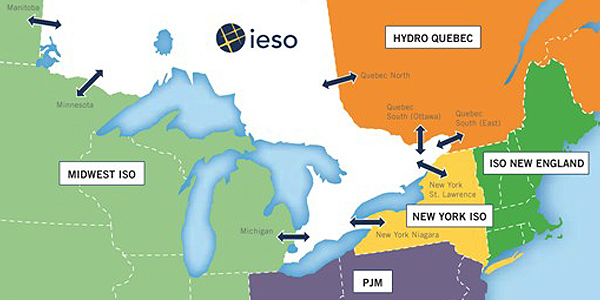By Rich Heidorn Jr.
NYISO stakeholders Wednesday approved moving the proxy bus for pricing transactions with Ontario’s Independent Electric System Operator (IESO) from the Bruce station to the Beck station to reflect power-flow changes resulting from the implementation of the Ontario-Michigan phase-angle regulators.
The proxy bus, intended to represent a typical bus in an adjacent control area, is where locational-based marginal prices are calculated.
NYISO Operations Analysis and Services Supervisor Tolu Dina told the Business Issues Committee that the implementation of the Ontario-Michigan PARs in July 2012 has resulted in 85 to 95% of IESO-NY interchange being delivered directly to New York rather than looping counterclockwise around Lake Erie as before the PARs.
Dina said the power flow of four free flow ties — the 345-kV Beck-Niagara (PA301) and Beck-Niagara (PA302), and the 230-kV Beck-Niagara (PA27) and Beck-Packard (BP76) — is affected by the external proxy bus location.
The current market model using the Bruce proxy assumes only 73% of the flow over the IESO-NY interface. The new model using the Beck bus will increase the model’s assumption to about 87% of the total.
Making the change is contingent on the replacement of NYISO’s energy management system (EMS) and business management system (BMS). The ISO is targeting April for updating its model to reflect the switch from Bruce to Beck.
As a transition, the spring 2020 transmission congestion contract (TCC) auction — expected to begin Feb. 7 and end April 9 — will only allow bids at the IESO bus for the six-month auction. No bids will be permitted at the bus for the one- and two-year rounds.
The BIC approved the change with no opposition.
2021-2025 ICAP Demand Curve Reset
The BIC also approved NYISO’s proposed Tariff change to modify how it calculates gross cost of new entry (CONE) escalation factor as part of the annual updates of the installed capacity demand curves.
The gross CONE escalation factor includes four components: changes in construction material costs, turbine generator costs, labor costs and general costs of goods and services.
The proposal would switch from the current methodology, which measures changes on a year-to-year basis, to one that measures changes over the term of each reset period using the first year as a baseline.
It is intended to address the New York Transmission Owners’ concerns that the current year-to-year determination could be misleading if past index values that are subsequently reutilized are updated by an index publisher or if the relative change in the cost components change at materially different rates over time, the ISO said.
If approved by the Management Committee on Jan. 22 and the Board of Directors in February, the changes will be filed with FERC in February or March.




